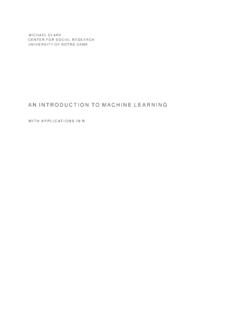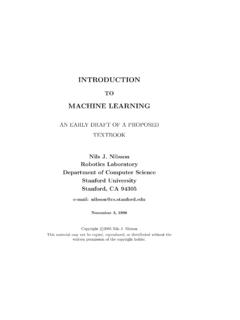Transcription of Introduction to Data Science - prod-edxapp.edx-cdn.org
1 Introduction to Data Science L ab 4 Intro duct io n to M achine L earni ng Overview In the previous labs, you explored a dataset containing details of lemonade sales. In this lab, you will use machine learning to train a predictive model that predicts daily lemonade sales based on variables such as the weather and the number of flyers distributed. You will then publish the model as a web service and use it from Excel. What You ll Need To complete the labs, you will need the following: A Windows, Linux, or Mac OS X computer with a web browser. A Microsoft account (for example a , or account). If you do not already have a Microsoft account, sign up for one at The lab files for this course.
2 Download these from , and extract them to a folder on your computer. Exercise 1: Creating a machine learning Model machine learning is a term used to describe the development of predictive models based on historic data. There are a variety of tools, languages, and frameworks you can use to create machine learning models; including R, the Sci-kit Learn package in Python, Apache Spark, and Azure machine learning . In this lab, you will use Azure machine learning Studio, which provides an easy to use web-based interface for creating machine learning models. The principles used to develop the model in this tool apply to most other machine learning development platforms, but the graphical nature of the Azure machine learning Studio environment makes it easier to focus on learning these principles without getting distracted by the code required to manipulate data and train the model.
3 Create an Azure machine learning Studio Workspace Note: If you already have an Azure machine learning workspace, you can skip this procedure and sign into Azure machine learning Studio at 1. In your web browser, navigate to , and if you don t already have a free Azure machine learning Studio workspace, click the option to sign up and choose the Free Workspace option and sign in using your Microsoft account. 2. After signing up, view the EXPERIMENTS tab in Azure machine learning Studio, which should look like this: Upload the Lemonade Dataset 1. In Azure machine learning Studio, click DATASETS. You should have no datasets of your own (clicking Samples will display some built-in sample datasets).
4 2. At the bottom left, click + NEW, and ensure that the DATASET tab is selected. 3. Click FROM LOCAL FILE. Then in the Upload a new dataset dialog box, browse to select the file in the folder where you extracted the lab files on your local computer and enter the following details as shown in the image below, and then click the ( ) icon. This is a new version of an existing dataset: Unselected Enter a name for the new dataset: Select a type for the new dataset: Generic CSV file with a header (.csv) Provide an optional description: Lemonade sales data. 4. Wait for the upload of the dataset to be completed, then verify that it is listed under MY DATASETS and click the OK ( ) button to hide the notification.
5 The file contains the original lemonade sales data in comma-delimited format. Create an Experiment and Explore the Data 1. In Azure machine learning Studio, click EXPERIMENTS. You should have no experiments in your workspace yet. 2. At the bottom left, click + NEW, and ensure that the EXPERIMENT tab is selected. Then click the Blank Experiment tile to create a new blank experiment. 3. At the top of the experiment canvas, change the experiment name to Lemonade Training as shown here: The experiment interface consists of a pane on the left containing the various items you can add to an experiment, a canvas area where you can define the experiment workflow, and a Properties pane where you can view and edit the properties of the currently selected item.
6 You can hide the experiment items pane and the Properties pane by clicking the < or > button to create more working space in the experiment canvas. 4. In the experiment items pane, expand Saved Datasets and My Datasets, and then drag the dataset onto the experiment canvas, as shown here: 5. Right-click the dataset output of the dataset and click Visualize as shown here: 1. In the data visualization, note that the dataset includes a record, often referred to as an observation or case, for each day, and each case has mulitple characteristics, or features in this example, the date, day of the week, temperature, rainfall, number of flyers distributed, and the price Rosie charged per lemonade that day.
7 The dataset also includes the number of sales Rosie made that day this is the label that ultimately you must train a machine learning model to predict based on the features. 2. Note the number of rows and columns in the dataset (which is very small real-world datasets for machine learning are typically much larger), and then select the column heading for the Temperature column and note the statistics about that column that are displayed, as shown here: 3. In the data visualization, scroll down if necessary to see the histogram for Temperature. This shows the distribution of different temperatures in the dataset: 4. Click the x icon in the top right of the visualization window to close it and return to the experiment canvas.
8 Explore Data in a Jupyter Notebook Jupyter Notebooks are often used by data scientists to explore data. They consist of an interactive browser-based environment in which you can add notes and run code to manipulate and visualize data. Azure machine learning Studio supports notebooks for two languages that are commonly used by data scientists: R and Python. Each language has its particular strengths, and both are prevalent among data scientists. In this lab, you can use either (or both). To Explore Data using Python: 1. Right-click the dataset output, and in the Open in a new Notebook sub-menu, click Python 3. This opens a new browser tab containing a Jupyter notebook with two cells, each containing some code.
9 The first cell contains code that loads the CSV dataset into a data frame named frame, similar to this: from azureml import Workspace ws = Workspace() ds = [' '] frame = () The second cell contains the following code, which displays a summary of the data frame: frame 2. On the Cell menu, click Run All to run all of the cells in the workbook. As the code runs, the O symbol next to Python 3 at the top right of the page changes to a symbol, and then returns to O when the code has finished running. 3. Observe the output from the second cell, which shows some rows of data from the dataset, as shown here: 1. Click cell 2 (which contains the code frame), and then on the Insert menu, click Insert Cell Below.
10 This adds a new cell to the notebook, under the output generated by cell 2. 2. Add the following code to the new empty cell (you can copy and paste this code from in the folder where you extracted the lab files for this course): %matplotlib inline from matplotlib import pyplot as plt # Print statistics for Temperature and Sales print(frame[['Temperature','Sales']].des cribe()) # Print correlation for temperature vs Sales print('\nCorrelation:') print(frame['Temperature'].corr(frame['S ales'])) # Plot Temperature vs Sales ('Temperature') ('Sales') () (frame['Temperature'],frame['Sales']) () 3. With the cell containing the new code selected, on the Cell menu, click Run Cells and Select Below (or click the | button on the toolbar) to run the cell, creating a new cell beneath.












